Influence of Dynamic Woody Debris Jam on Single Bridge Pier Scour and Induced Hydraulic Head
Abstract
:1. Introduction
2. Materials and Methods
2.1. Experiment Setup
2.2. Instrument Calibration and Error Evaluation
2.3. Experiment Matrix
2.4. Scale Effects
2.5. Procedures
3. Results
3.1. Scour Depth
3.2. Woody Debris Jam
3.3. Time-History of the Water Level
4. Analysis
4.1. Debris Jam-Induced Hydraulic Head
4.2. Scour Depth Influenced by Woody Debris Jam
5. Discussion
6. Conclusions
Author Contributions
Funding
Institutional Review Board Statement
Informed Consent Statement
Data Availability Statement
Acknowledgments
Conflicts of Interest
Abbreviations
| blockage ratio by the projected vertical area of debris jam; | |
| blockage ratio by the horizontal plan area of debris jam; | |
| width of flume; | |
| effective width or diameter of the pier; | |
| width or diameter of the pier. | |
| median size distribution of particles; | |
| equilibrium scour depth in the presence of woody debris jam at time t; | |
| equilibrium scour depth without the presence of debris jam at time t; | |
| Fr | Froude number; |
| the debris induced hydraulic head; | |
| the difference in water surface elevation between the front ultrasonic distance sensor and the posterior one in the presence of woody debris; | |
| difference of water surface elevation between the front ultrasonic distance sensor and the posterior one without woody debris; | |
| approach flow depth; | |
| the height of woody debris jam from the bottom of debris jam to water surface; | |
| length of woody debris jam in streamwise direction. | |
| the influence of debris jam on scour ; | |
| for initial woody debris jam; | |
| for the subsequent woody debris jam; | |
| the maximum value of in the first woody debris jam; | |
| a coefficient to connect parameter the first or previous woody debris jam, averaging close to 1.0; | |
| the bed roughness; | |
| the Reynold number; | |
| the time moment; | |
| width of woody debris jam normal to flow; | |
| mean velocity of approach flow | |
| local velocity at height z above the mean bed elevation; | |
| shear velocity; | |
| 0.79 for rectangular debris and 0.21 for triangular debris; | |
| −0.79 for rectangular debris and −0.17 for triangular debris, 0 when ; | |
| parameter 0.32 or 3.2. | |
| von Karman constant (0.41); | |
| sediment gradation; | |
| scale factor |
References
- Haehnel, R.B.; Daly, S.F. Maximum Impact Force of Woody Debris on Floodplain Structures. J. Hydraul. Eng. 2004, 130, 112–120. [Google Scholar] [CrossRef]
- Stolle, J.; Derschum, C.; Goseberg, N.; Nistor, I.; Petriu, E. Debris impact under extreme hydrodynamic conditions part 2: Impact force responses for non-rigid debris collisions. Coast. Eng. 2018, 141, 107–118. [Google Scholar] [CrossRef]
- Hasanpour, A.; Istrati, D.; Buckle, I. Coupled SPH–FEM Modeling of Tsunami-Borne Large Debris Flow and Impact on Coastal Structures. J. Mar. Sci. Eng. 2021, 9, 1068. [Google Scholar] [CrossRef]
- Hasanpour, A.; Istrati, D.; Buckle, I.G. Multi-Physics Modeling of Tsunami Debris Impact on Bridge Decks. In Proceedings of the 3rd International Conference on Natural Hazards & Infrastructure, Athens, Greece, 5–7 July 2022; pp. 5–7. [Google Scholar]
- Oudenbroek, K.; Naderi, N.; Bricker, J.D.; Yang, Y.; Van der Veen, C.; Uijttewaal, W.; Moriguchi, S.; Jonkman, S.N. Hydrodynamic and Debris-Damming Failure of Bridge Decks and Piers in Steady Flow. Geosciences 2018, 8, 409. [Google Scholar] [CrossRef] [Green Version]
- Istrati, D.; Hasanpour, A.; Buckle, I. Numerical investigation of tsunami-borne debris damming loads on a coastal bridge. In Proceedings of the 17 World Conference on Earthquake Engineering, Sendai, Japan, 13–18 September 2020. [Google Scholar]
- Pagliara, S.; Carnacina, I. Influence of Wood Debris Accumulation on Bridge Pier Scour. J. Hydraul. Eng. 2011, 137, 254–261. [Google Scholar] [CrossRef]
- Mazzorana, B.; Zischg, A.P.; Largiader, A.; Hübl, J. Hazard index maps for woody material recruitment and transport in alpine catchments. Nat. Hazards Earth Syst. Sci. 2009, 9, 197–209. [Google Scholar] [CrossRef] [Green Version]
- Mazzorana, B.; Hübl, J.; Zischg, A.; Largiader, A.J.N.H. Modelling woody material transport and deposition in alpine rivers. Nat. Hazards 2011, 56, 425–449. [Google Scholar] [CrossRef] [Green Version]
- Comiti, F.; Lucía, A.; Rickenmann, D. Large wood recruitment and transport during large floods: A review. Geomorphology 2016, 269, 23–39. [Google Scholar] [CrossRef]
- Ruiz-Villanueva, V.; Piégay, H.; Gurnell, A.M.; Marston, R.A.; Stoffel, M. Recent advances quantifying the large wood dynamics in river basins: New methods and remaining challenges. Rev. Geophys. 2016, 54, 611–652. [Google Scholar] [CrossRef] [Green Version]
- Tonon, A.; Picco, L.; Rainato, R. Test of methodology for developing a large wood budget: A 1-year example from a regulated gravel bed river following ordinary floods. CATENA 2018, 165, 115–124. [Google Scholar] [CrossRef]
- Klaar, M.J.; Hill, D.F.; Maddock, I.; Milner, A.M. Interactions between instream wood and hydrogeomorphic development within recently deglaciated streams in Glacier Bay National Park, Alaska. Geomorphology 2011, 130, 208–220. [Google Scholar] [CrossRef]
- Braudrick, C.A.; Grant, G.E. When do logs move in rivers? Water Resour. Res. 2000, 36, 571–583. [Google Scholar] [CrossRef] [Green Version]
- Braudrick, C.A.; Grant, G.E.; Ishikawa, Y.; Ikeda, H. Dynamics of Wood Transport in Streams: A Flume Experiment. Earth Surf. Process. Landf. 1997, 22, 669–683. [Google Scholar] [CrossRef]
- Braudrick, C.A.; Grant, G.E. Transport and deposition of large woody debris in streams: A flume experiment. Geomorphology 2001, 41, 263–283. [Google Scholar] [CrossRef]
- Bocchiola, D.; Rulli, M.C.; Rosso, R. Transport of large woody debris in the presence of obstacles. Geomorphology 2006, 76, 166–178. [Google Scholar] [CrossRef]
- Chen, S.-C.; Tfwala, S.S.; Wang, C.-R.; Kuo, Y.-M.; Chao, Y.-C. Incipient motion of large wood in river channels considering log density and orientation. J. Hydraul. Res. 2019, 58, 489–502. [Google Scholar] [CrossRef]
- Crosato, A.; Rajbhandari, N.; Comiti, F.; Cherradi, X.; Uijttewaal, W. Flume experiments on entrainment of large wood in low-land rivers. J. Hydraul. Res. 2013, 51, 581–588. [Google Scholar] [CrossRef]
- Haga, H.; Kumagai, T.o.; Otsuki, K.; Ogawa, S. Transport and retention of coarse woody debris in mountain streams: An in situ field experiment of log transport and a field survey of coarse woody debris distribution. Water Resour. Res. 2002, 38, 1–16. [Google Scholar] [CrossRef]
- Davidson, S.L.; MacKenzie, L.G.; Eaton, B.C. Large wood transport and jam formation in a series of flume experiments. Water Resour. Res. 2015, 51, 10065–10077. [Google Scholar] [CrossRef]
- Persi, E.; Petaccia, G.; Sibilla, S.J.N.H. Large wood transport modelling by a coupled Eulerian–Lagrangian approach. Nat. Hazards 2018, 91, 59–74. [Google Scholar] [CrossRef]
- Diehl, T.H. Potential Drift Accumulation at Bridges; US Department of Transportation, Federal Highway Administration, Research and Development, Turner-Fairbank Highway Research Center: Washington, DC, USA, 1997.
- Arneson, L.; Zevenbergen, L.; Lagasse, P.; Clopper, P. Evaluating Scour at Bridges; National Highway Institute: Arlington, VA, USA, 2012. [Google Scholar]
- Melville, B.W. Local Scour at Bridge Abutments. J. Hydraul. Eng. 1992, 118, 615–631. [Google Scholar] [CrossRef]
- Kothyari, U.C.; Garde, R.C.J.; Raju, K.G.R. Temporal Variation of Scour Around Circular Bridge Piers. J. Hydraul. Eng. 1992, 118, 1091–1106. [Google Scholar] [CrossRef]
- Kothyari, U.C.; Ranga Raju, K.G.; Garde, R.J. Live-bed scour around cylindrical bridge piers. J. Hydraul. Res. 1992, 30, 701–715. [Google Scholar] [CrossRef]
- Lu, J.-Y.; Shi, Z.-Z.; Hong, J.-H.; Lee, J.-J.; Raikar, R.V. Temporal Variation of Scour Depth at Nonuniform Cylindrical Piers. J. Hydraul. Eng. 2011, 137, 45–56. [Google Scholar] [CrossRef] [Green Version]
- Mia, M.F.; Nago, H. Design Method of Time-Dependent Local Scour at Circular Bridge Pier. J. Hydraul. Eng. 2003, 129, 420–427. [Google Scholar] [CrossRef]
- Yanmaz, A.M.; Altinbilek, H.D.a. Study of Time-Depenbent Local Scour around Bridge Piers. J. Hydraul. Eng. 1991, 117, 1247–1268. [Google Scholar] [CrossRef]
- Dey, S. Time-variation of scour in the vicinity of circular piers. Proc. Inst. Civ. Eng. 1999, 136, 67–75. [Google Scholar] [CrossRef]
- Yanmaz, A.M. Temporal variation of clear water scour at cylindrical bridge piers. Can. J. Civ. Eng. 2006, 33, 1098–1102. [Google Scholar] [CrossRef]
- Yanmaz, A.M.; Kose, O. A semi-empirical model for clear-water scour evolution at bridge abutments. J. Hydraul. Res. 2009, 47, 110–118. [Google Scholar] [CrossRef]
- Yilmaz, M.; Yanmaz, A.M.; Koken, M. Clear-water scour evolution at dual bridge piers. Can. J. Civ. Eng. 2017, 44, 298–307. [Google Scholar] [CrossRef]
- Aksoy, A.O.; Bombar, G.; Arkis, T.; Guney, M.S. Study of the time-dependent clear water scour around circular bridge piers. J. Hydrol. Hydromech. 2017, 65, 26–34. [Google Scholar] [CrossRef] [Green Version]
- Chang, W.-Y.; Lai, J.-S.; Yen, C.-L. Evolution of Scour Depth at Circular Bridge Piers. J. Hydraul. Eng. 2004, 130, 905–913. [Google Scholar] [CrossRef]
- Melville, B.W.; Chiew, Y.-M. Time Scale for Local Scour at Bridge Piers. J. Hydraul. Eng. 1999, 125, 59–65. [Google Scholar] [CrossRef]
- Oliveto, G.; Hager, W.H. Temporal Evolution of Clear-Water Pier and Abutment Scour. J. Hydraul. Eng. 2002, 128, 811–820. [Google Scholar] [CrossRef]
- Melville, B.W. Pier and Abutment Scour: Integrated Approach. J. Hydraul. Eng. 1997, 123, 125–136. [Google Scholar] [CrossRef]
- Lagasse, P.F.; Clopper, P.E.; Zevenbergen, L.W.; Spitz, W.J.; Girard, L.G. Effects of Debris on Bridge Pier Scour; Transportation Research Board: Washington, DC, USA, 2010; p. 0309118344. [Google Scholar]
- Pagliara, S.; Carnacina, I. Bridge pier flow field in the presence of debris accumulation. Proc. Inst. Civ. Eng. Water Manag. 2013, 166, 187–198. [Google Scholar] [CrossRef]
- Melville, B.W.; Dongol, D.M. Bridge pier scour with debris accumulation. J. Hydraul. Eng. 1992, 118, 1306. [Google Scholar] [CrossRef]
- Lagasse, P.F.; Zevenbergen, L.W.; Clopper, P.E. Impacts of debris on bridge pier scour. In Proceedings of the 5th International Conference on Scour and Erosion (ICSE-5), San Francisco, CA, USA, 7–10 November 2010; pp. 854–863. [Google Scholar]
- Pagliara, S.; Carnacina, I. Temporal scour evolution at bridge piers: Effect of wood debris roughness and porosity. J. Hydraul. Res. 2010, 48, 3–13. [Google Scholar] [CrossRef]
- Pagliara, S.; Carnacina, I.; Cigni, F. Sills and gabions as countermeasures at bridge pier in presence of debris accumulations. J. Hydraul. Res. 2010, 48, 764–774. [Google Scholar] [CrossRef]
- Pagliara, S.; Carnacina, I. Influence of large woody debris on sediment scour at bridge piers. Int. J. Sediment Res. 2011, 26, 121–136. [Google Scholar] [CrossRef]
- Ebrahimi, M.; Kripakaran, P.; Prodanović, D.M.; Kahraman, R.; Riella, M.; Tabor, G.; Arthur, S.; Djordjević, S. Experimental Study on Scour at a Sharp-Nose Bridge Pier with Debris Blockage. J. Hydraul. Eng. 2018, 144, 04018071. [Google Scholar] [CrossRef] [Green Version]
- Panici, D.; de Almeida, G.A.M. Formation, Growth, and Failure of Debris Jams at Bridge Piers. Water Resour. Res. 2018, 54, 6226–6241. [Google Scholar] [CrossRef]
- Schalko, I.; Schmocker, L.; Weitbrecht, V.; Boes, R.M. Laboratory study on wood accumulation probability at bridge piers. J. Hydraul. Res. 2019, 58, 566–581. [Google Scholar] [CrossRef]
- Rennie, C.D.; Hay, A. Reynolds Stress Estimates in a Tidal Channel from Phase-Wrapped ADV Data. J. Coast. Res. 2010, 2010, 157–166. [Google Scholar] [CrossRef]
- Rennie, C.D.; Church, M. Mapping spatial distributions and uncertainty of water and sediment flux in a large gravel bed river reach using an acoustic Doppler current profiler. J. Geophys. Res. Earth Surf. 2010, 115. [Google Scholar] [CrossRef] [Green Version]
- Melville, B.W.; Sutherland, A.J. Design Method for Local Scour at Bridge Piers. J. Hydraul. Eng. 1988, 114, 1210–1226. [Google Scholar] [CrossRef]
- Manners, R.B.; Doyle, M.W. A mechanistic model of woody debris jam evolution and its application to wood-based restoration and management. River Res. Appl. 2008, 24, 1104–1123. [Google Scholar] [CrossRef]
- Panici, D.; de Almeida, G.A.M. A theoretical analysis of the fluid–solid interactions governing the removal of woody debris jams from cylindrical bridge piers. J. Fluid Mech. 2020, 886, A19. [Google Scholar] [CrossRef]
- Parola, A.C.; Apelt, C.J.; Jempson, M.A. Debris Forces on Highway Bridges; Transportation Research Board: Washington, DC, USA, 2000. [Google Scholar]



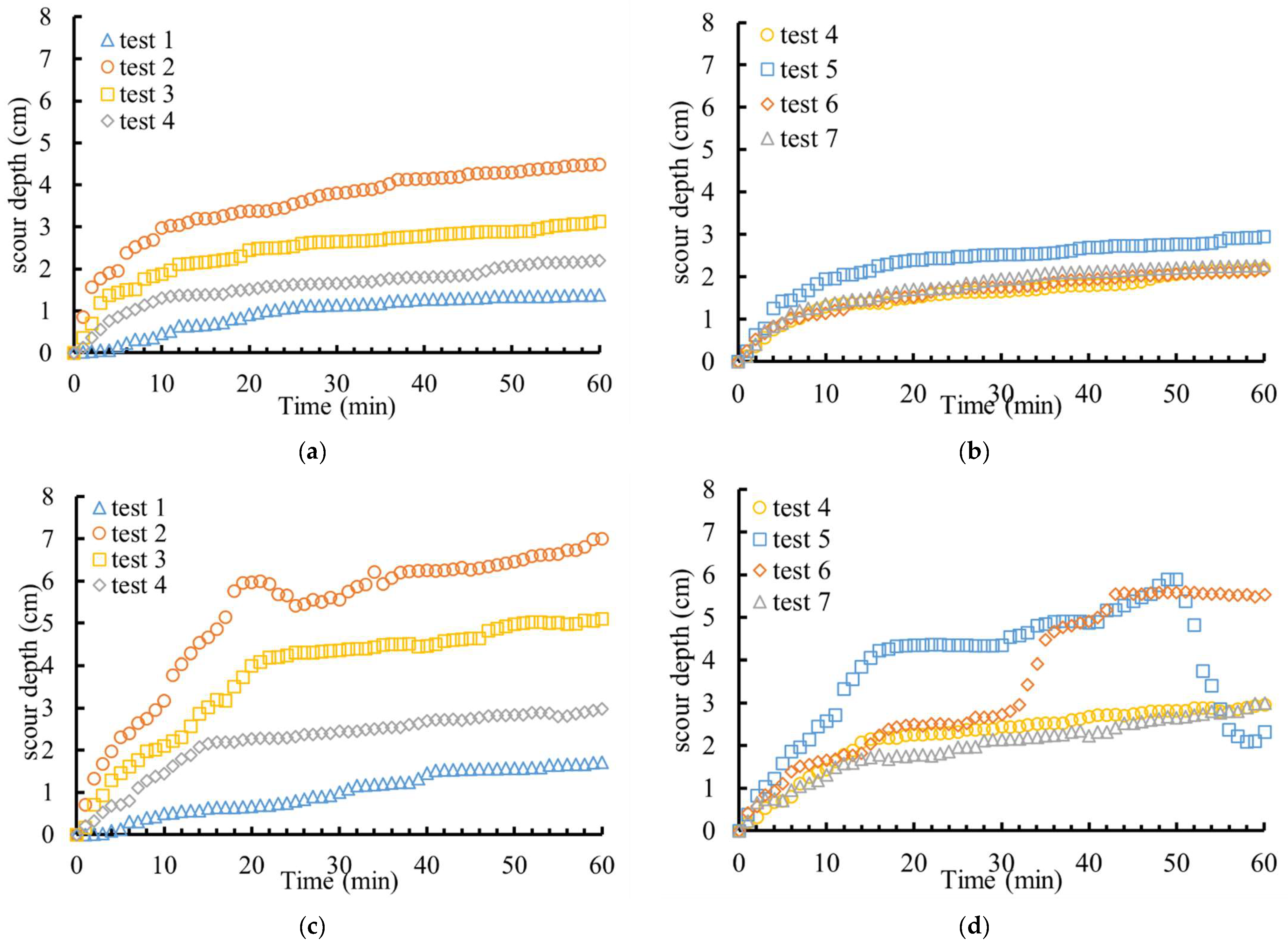
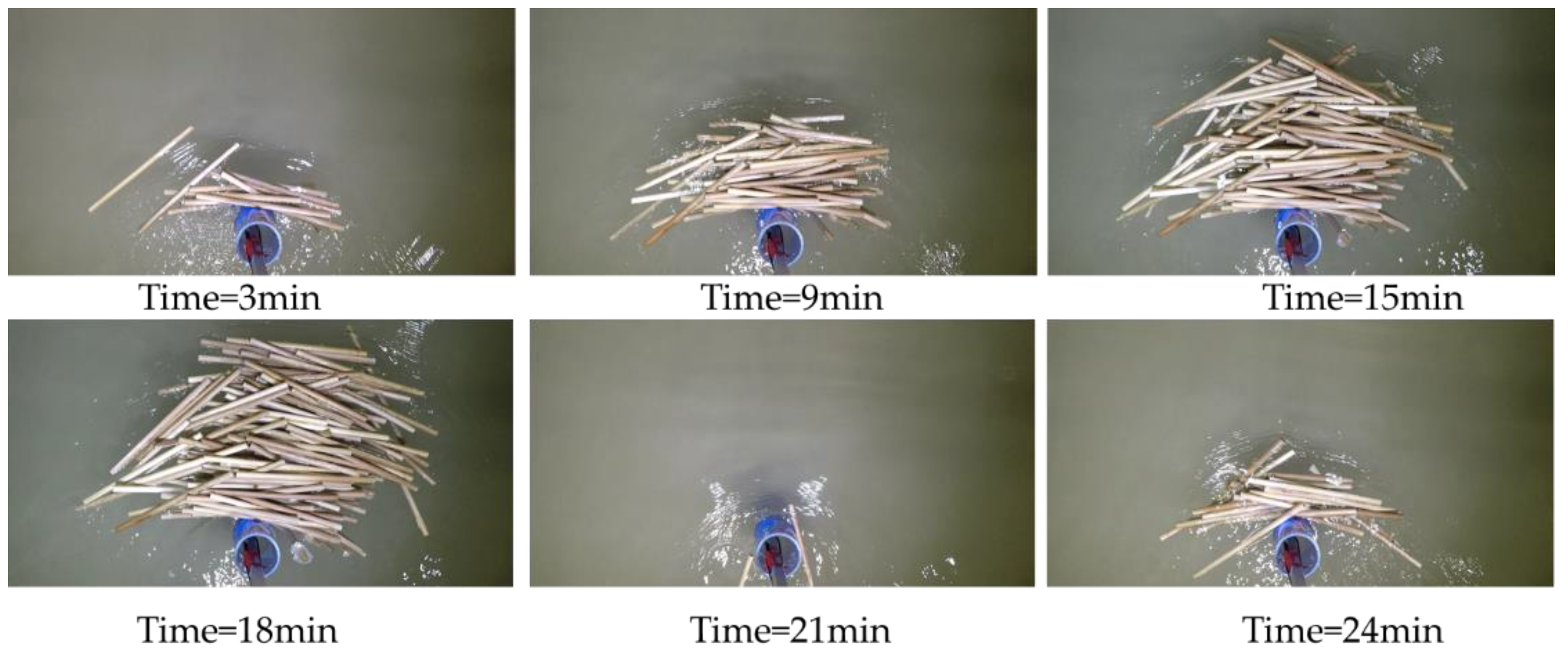
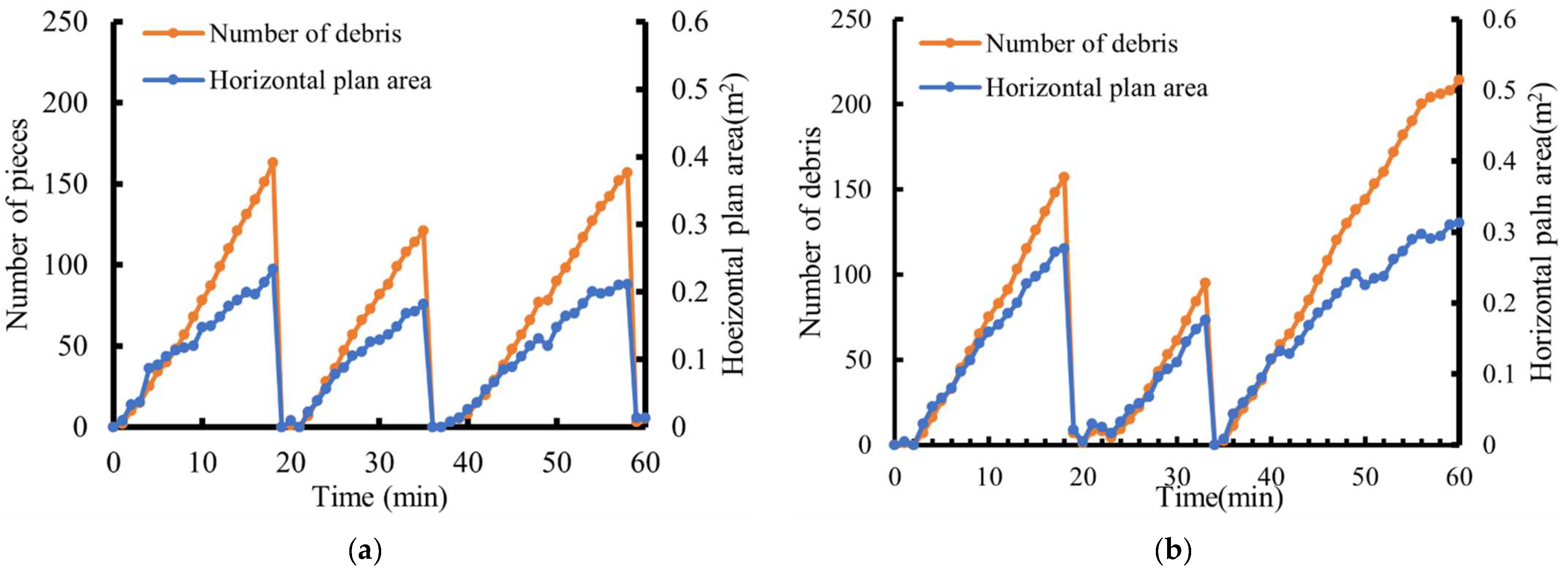
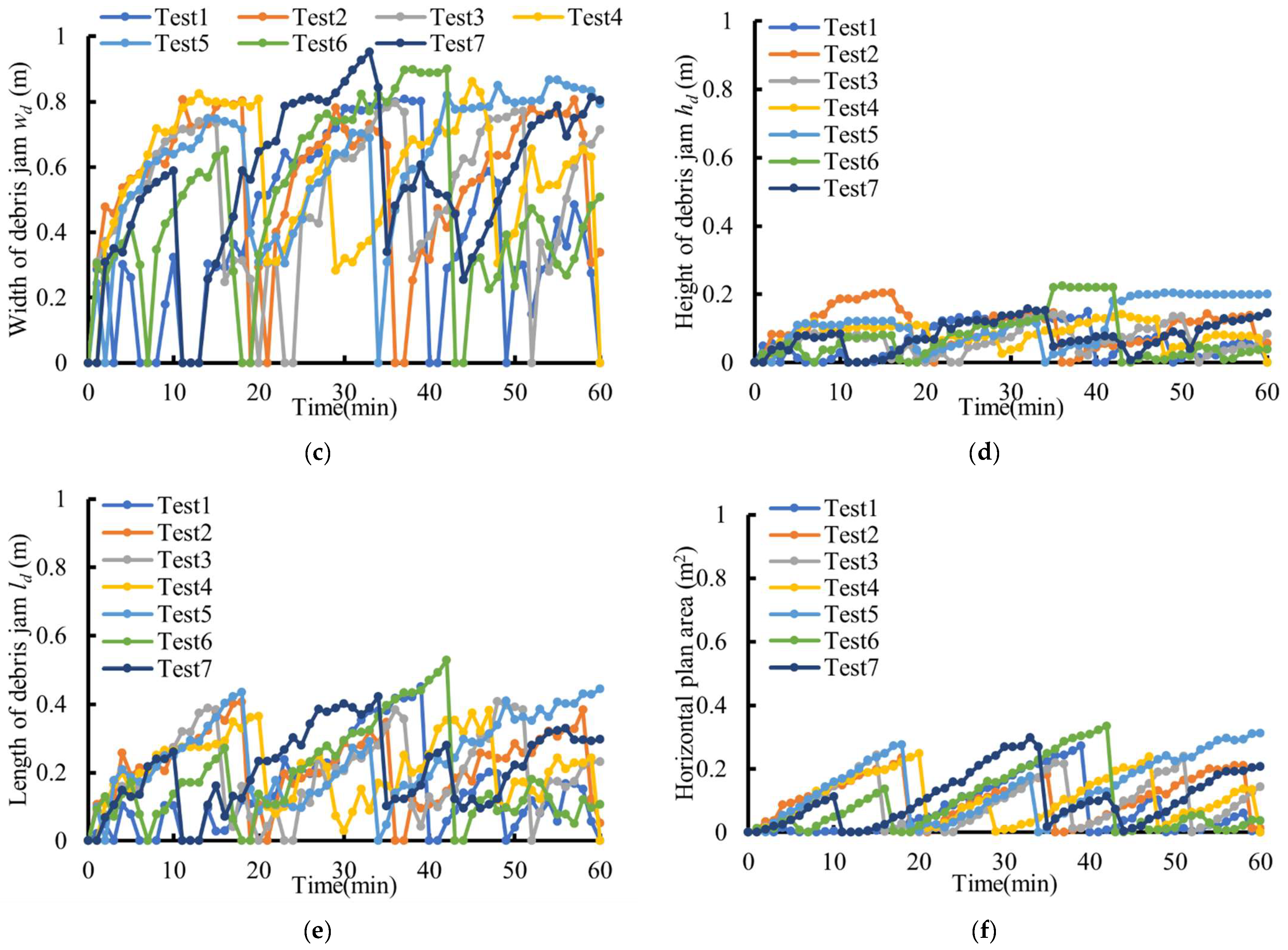
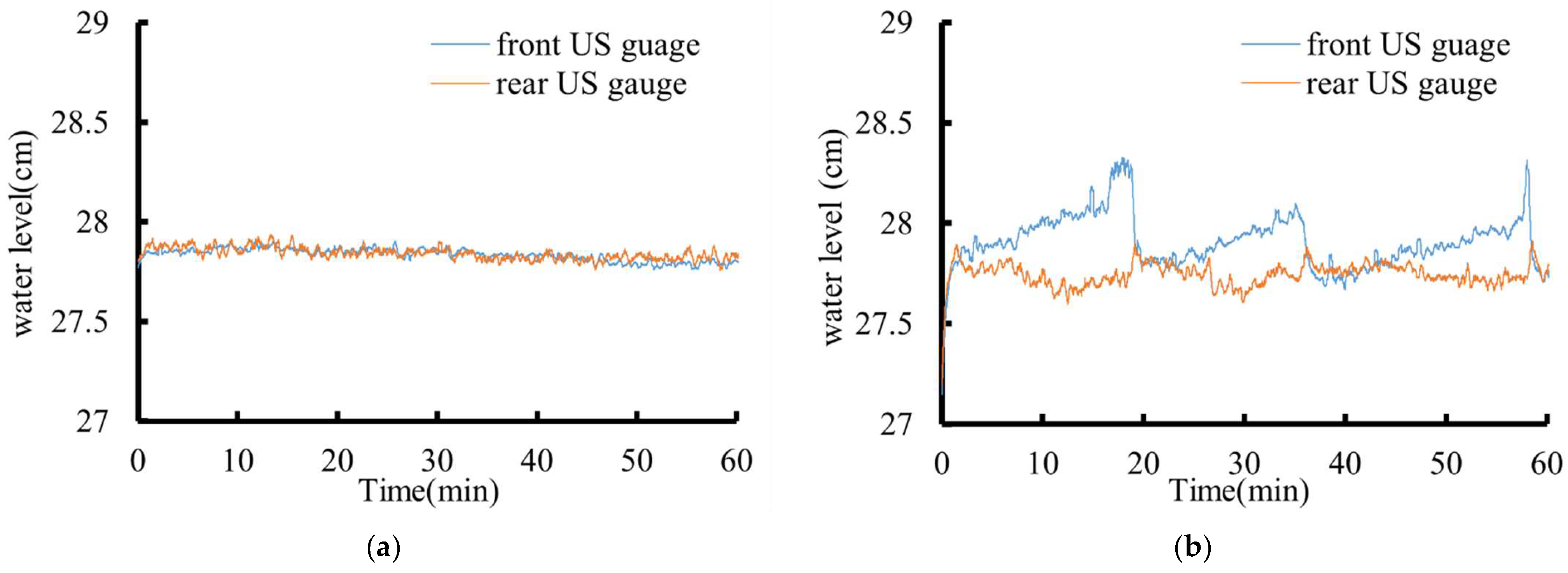
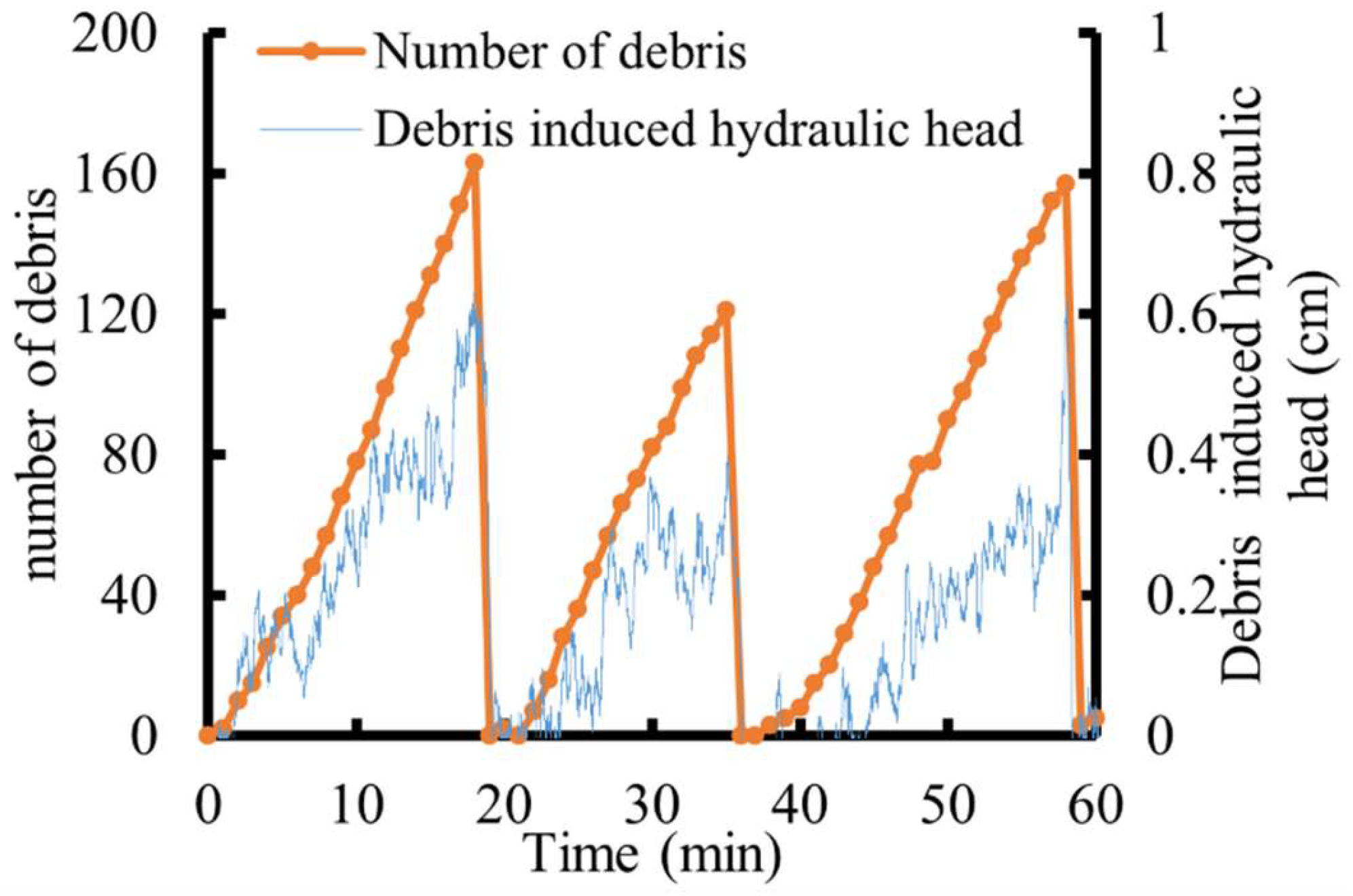
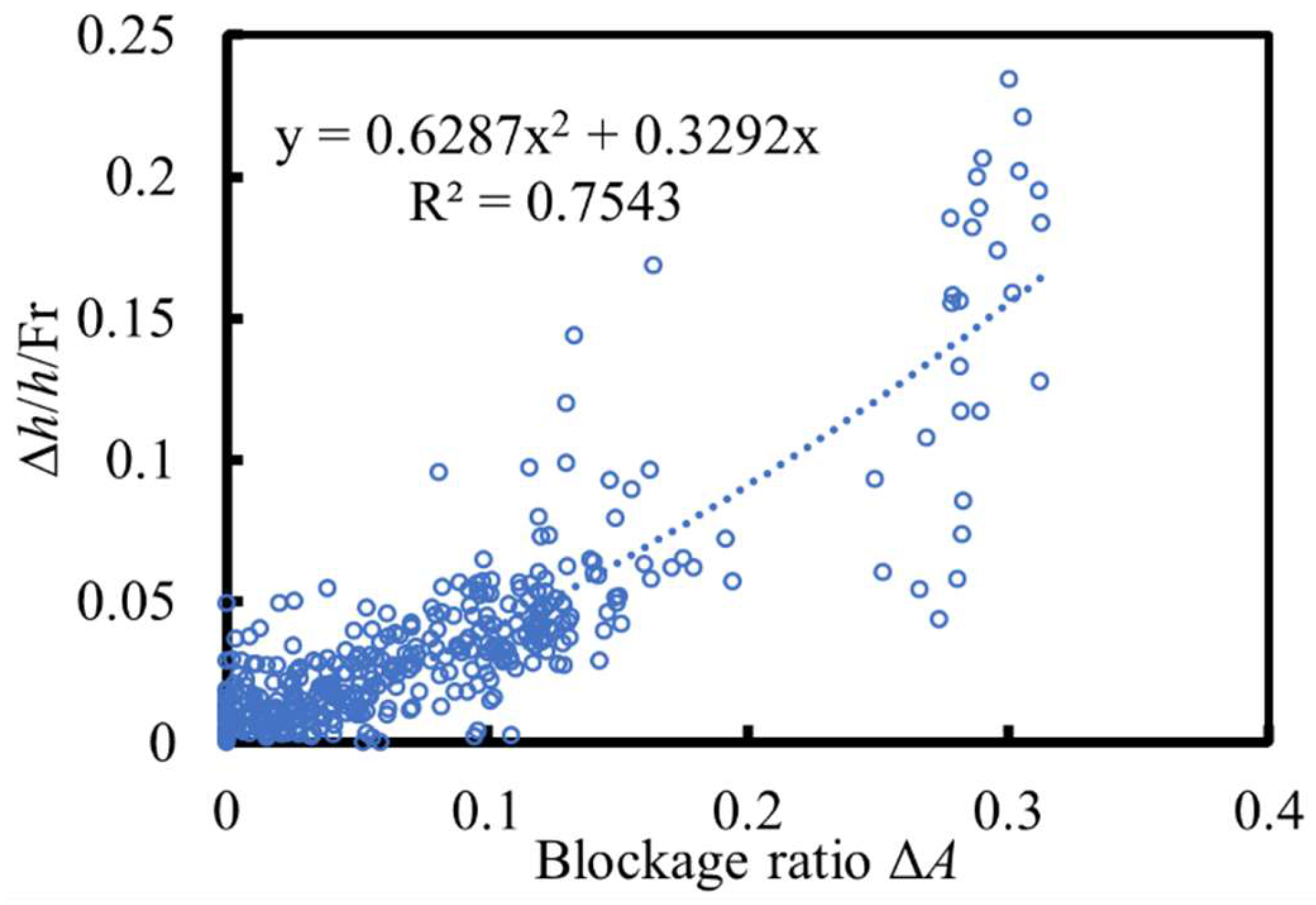


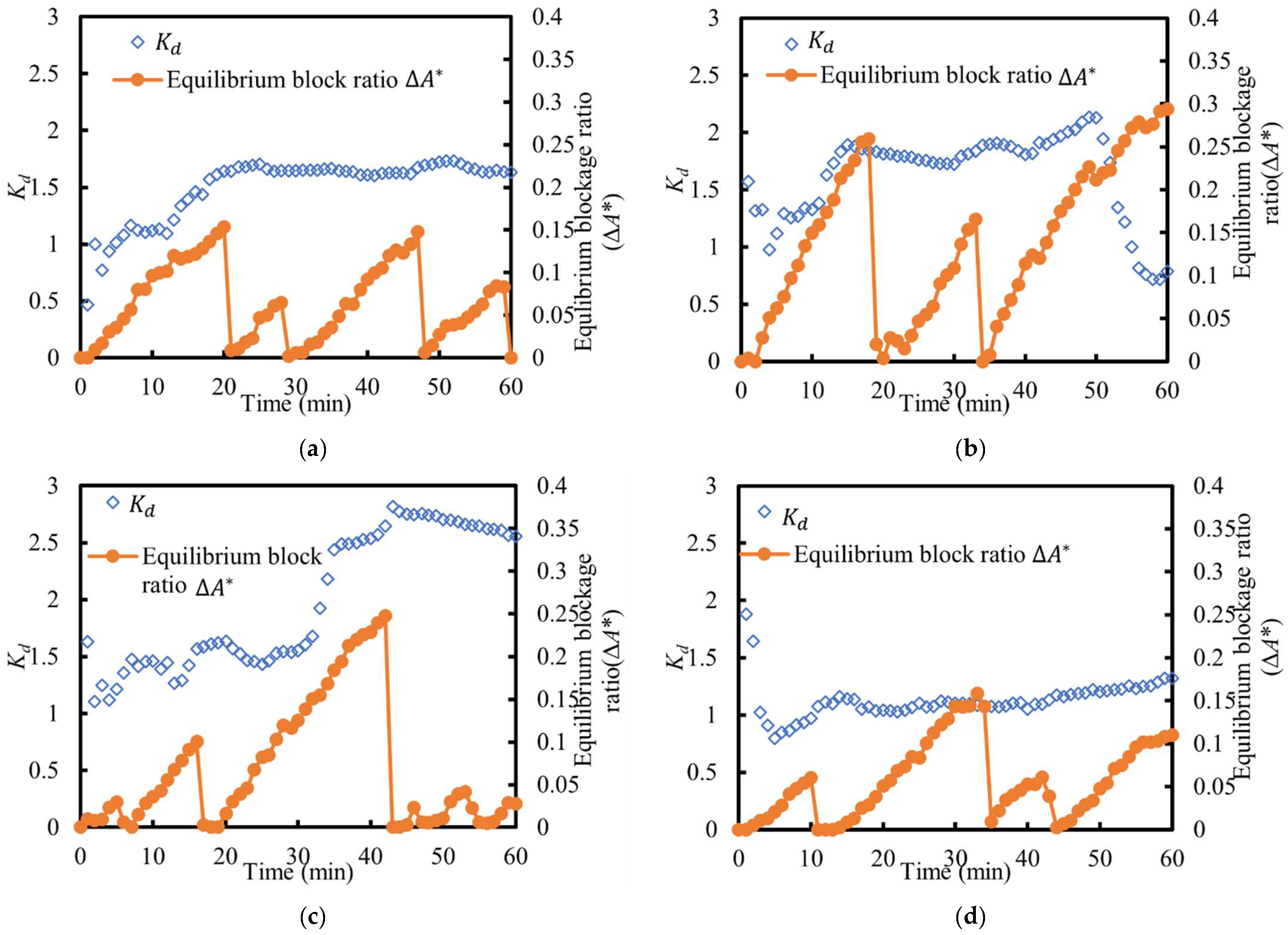
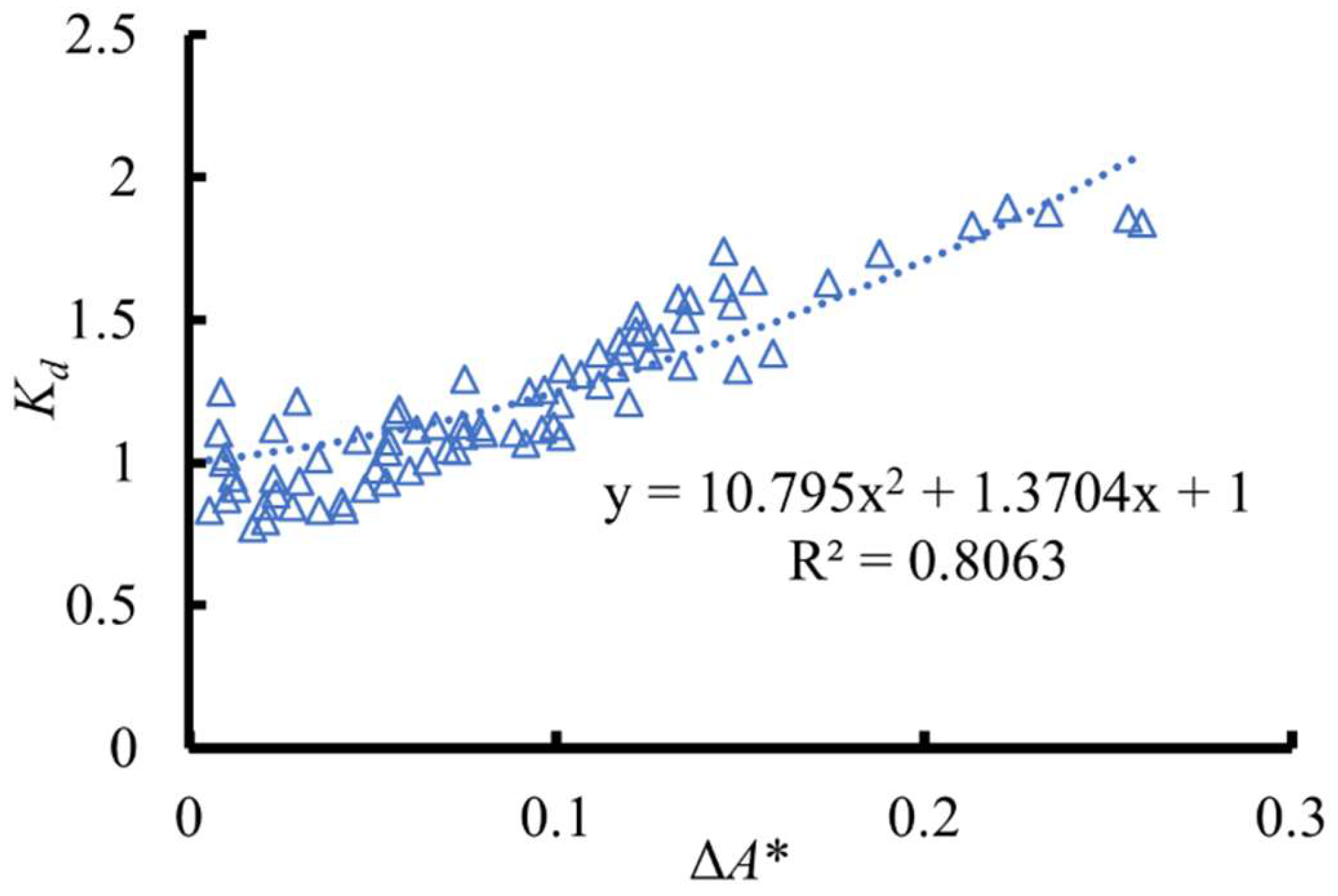

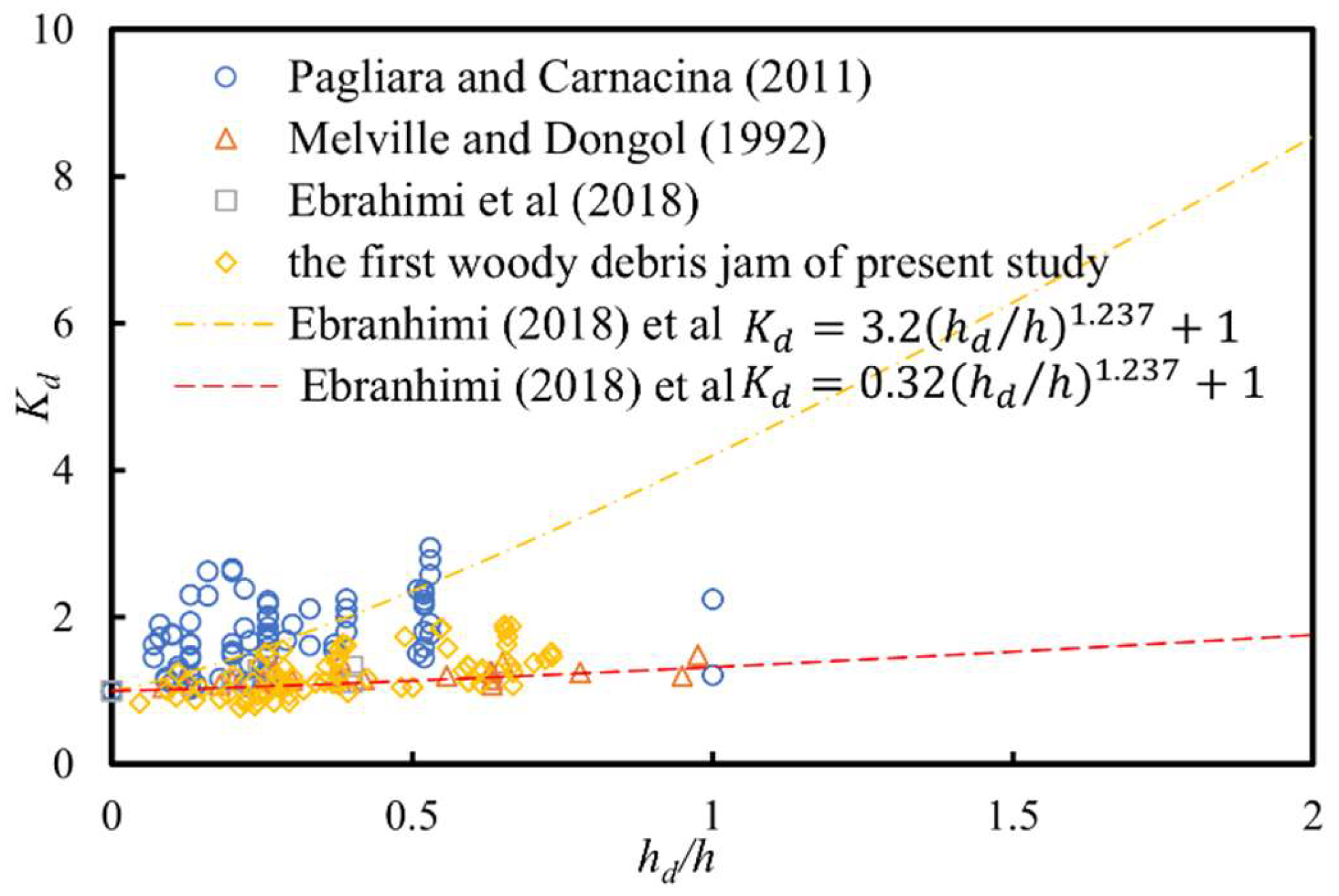
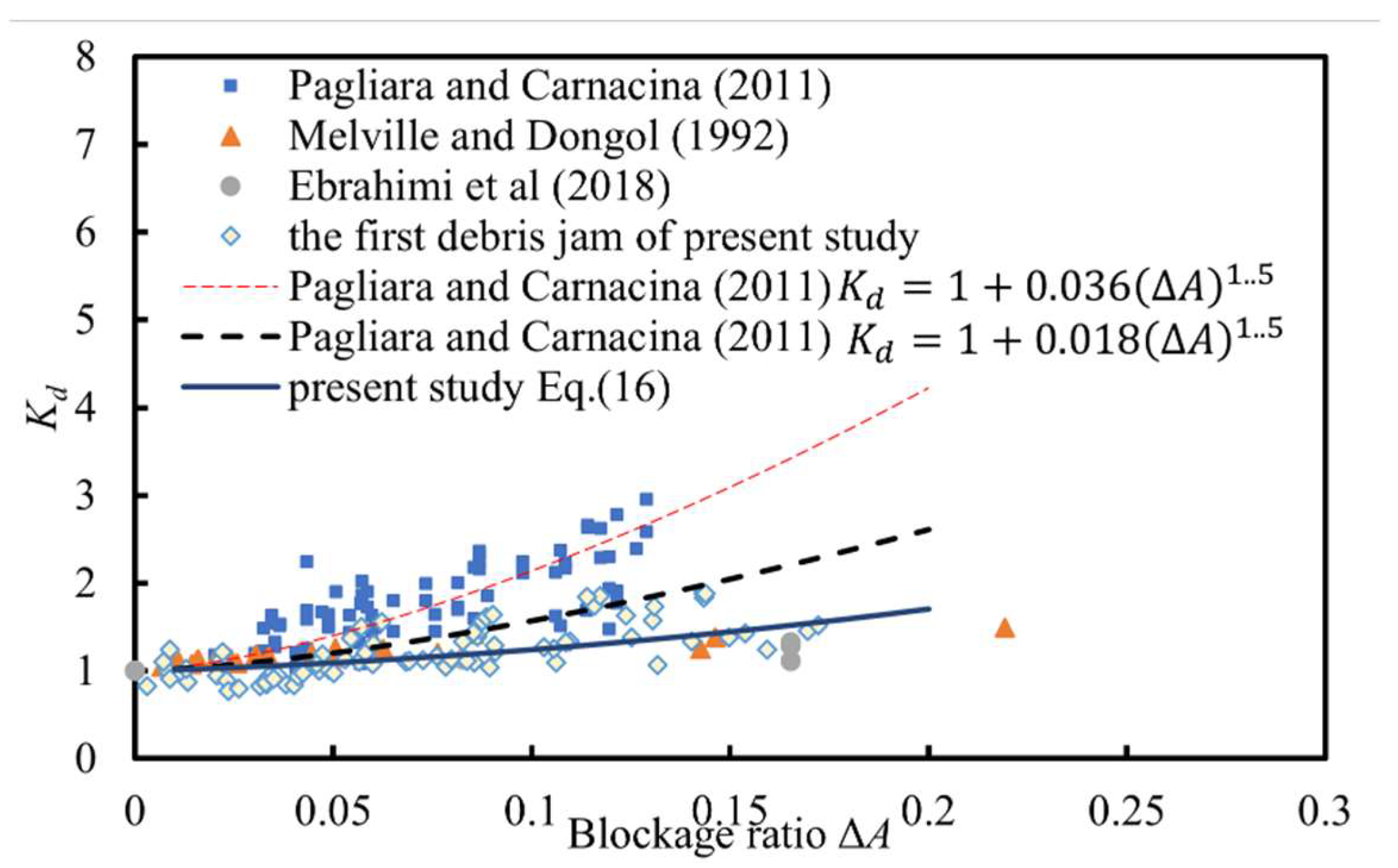
| Test Number | Water Depth h (m) | Mean Velocity U (m/s) | Shear Velocity (m/s) | Froude Number, Fr | Dowel Size Applied | |
|---|---|---|---|---|---|---|
| 1 | 0.284 | 0.223 | 0.0129 | 0.157 | 0.506 | 30 cm in length and 1.27 cm for diameter |
| 2 | 0.278 | 0.311 | 0.0150 | 0.221 | 0.707 | |
| 3 | 0.281 | 0.273 | 0.0119 | 0.193 | 0.620 | |
| 4 | 0.286 | 0.250 | 0.00959 | 0.175 | 0.566 | |
| 5 | 0.184 | 0.256 | 0.0112 | 0.214 | 0.617 | |
| 6 | 0.234 | 0.246 | 0.0105 | 0.186 | 0.573 | |
| 7 | 0.326 | 0.257 | 0.0106 | 0.172 | 0.572 |
Publisher’s Note: MDPI stays neutral with regard to jurisdictional claims in published maps and institutional affiliations. |
© 2022 by the authors. Licensee MDPI, Basel, Switzerland. This article is an open access article distributed under the terms and conditions of the Creative Commons Attribution (CC BY) license (https://creativecommons.org/licenses/by/4.0/).
Share and Cite
Zhang, W.; Nistor, I.; Rennie, C.D.; Almansour, H. Influence of Dynamic Woody Debris Jam on Single Bridge Pier Scour and Induced Hydraulic Head. J. Mar. Sci. Eng. 2022, 10, 1421. https://doi.org/10.3390/jmse10101421
Zhang W, Nistor I, Rennie CD, Almansour H. Influence of Dynamic Woody Debris Jam on Single Bridge Pier Scour and Induced Hydraulic Head. Journal of Marine Science and Engineering. 2022; 10(10):1421. https://doi.org/10.3390/jmse10101421
Chicago/Turabian StyleZhang, Wenjun, Ioan Nistor, Colin D. Rennie, and Husham Almansour. 2022. "Influence of Dynamic Woody Debris Jam on Single Bridge Pier Scour and Induced Hydraulic Head" Journal of Marine Science and Engineering 10, no. 10: 1421. https://doi.org/10.3390/jmse10101421
APA StyleZhang, W., Nistor, I., Rennie, C. D., & Almansour, H. (2022). Influence of Dynamic Woody Debris Jam on Single Bridge Pier Scour and Induced Hydraulic Head. Journal of Marine Science and Engineering, 10(10), 1421. https://doi.org/10.3390/jmse10101421









